If You Plant It, Will They Come?
This article by Randi was originally published in the Spring 2020 issue of Skylands Visitor magazine.
Insects are critical components of any natural area. Gardeners have become increasingly aware that, if we want wildlife in our gardens, we must support all life stages, year 'round. With the fragmented state of our natural areas, wildlife relies on our gardens, yards, fields, hedgerows, and woodlots to survive. When using native plants in a landscape, we are attempting to recreate functioning ecosystems to support the wonderful wildlife that, in fact, needs us to survive.
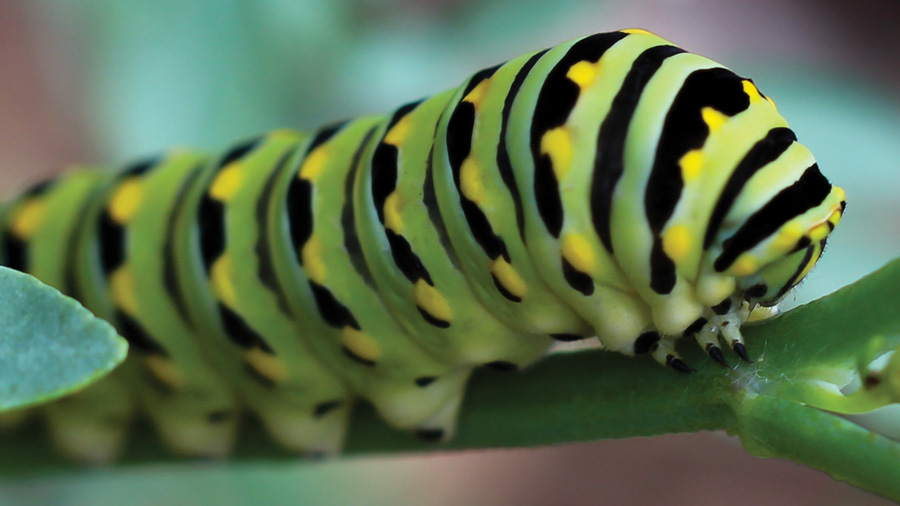
Caterpillar of the black swallowtail (Papilio polyxenes), the state butterfly of New Jersey.
|
Insects of all kinds fulfill critical, and under-appreciated, roles in our lives. They are pollinators, herbivores, predators, and parasites. In a balanced ecosystem, there are rarely outbreaks of any particular insect species because, in the humorous words of Victorian mathematician Augustus De Morgan: "Great fleas have little fleas upon their backs to bite 'em, And little fleas have lesser fleas, and so ad infinitum." |
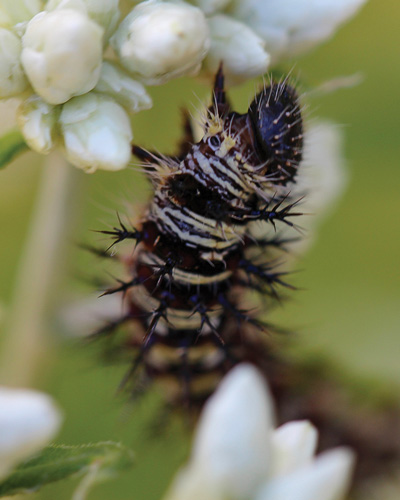 American lady butterfly caterpillar (Vanessa virginiensis) feeding on sweet everlasting (Pseudognapthalium obtusifolium). These caterpillars have a very narrow host range, but they will also feed on pussytoes (Antennaria sp.) |
|
Near the very bottom of the food chain, insects are the primary consumers of plant matter on the planet. Leaves, bark, seeds, roots, flowers, rotten wood-they eat it all. Most insects die young because they, in turn, are the primary food source for a great deal of the animals on our planet. Many caterpillars never grow up to be butterflies and moths, but rather are fed upon by birds and fed to their young. Doug Tallamy, author of Bringing Nature Home (among other wonderful books), has found that a single nest of black-capped chickadees needs 390-570 caterpillars a day to keep the young birds fed. Hummingbirds do not raise their young on nothing but nectar. They need protein, which they get from hunting small, soft-bodied creatures such as aphids, gnats, and spiders. |
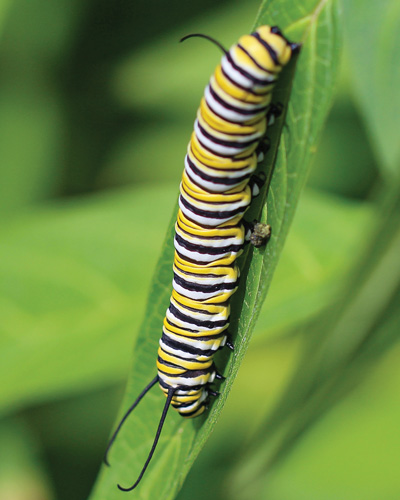 A monarch butterfly caterpillar (Danaus plexippus) on a butterfly milkweed leaf (Asclepias tuberosa). A surprising number of folks who plant milkweed in their gardens to support monarch butterflies are unaware of what a monarch caterpillar even looks like. |
|
In the United States, the number of described insect species is approximately 91,000. The undescribed species of insects in the United States, however, is estimated at some 73,000. If that doesn't give you pause for thought, a Pennsylvania study found that there are approximately 130 million insects per acre in the top five inches of soil! Fortunately, most of these are beneficial or benign, and you will never see or notice them. Unfortunately for them, we tend to fear what we do not know, and increasingly folks are inclined to kill every insect they see that is not a monarch butterfly or a honey bee, the two most popular poster children of insect conservation. |
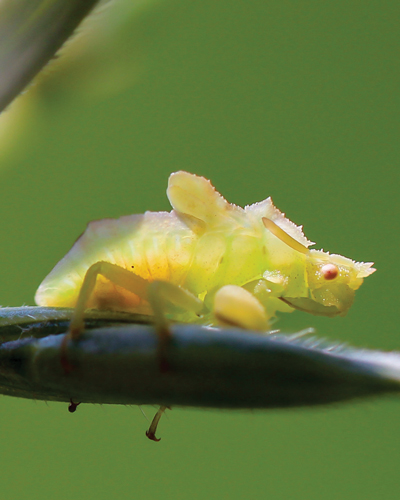 A tiny but fierce immature jagged ambush bug (Phymata pennsylvanica) waiting for its next insect meal. |
|
Recent studies have reported widespread declines in insect populations around the world, and the potential consequences are, indeed, huge. Without predators and parasites to keep them at bay, pest populations (including insects that feed on our crops) may explode. The Center for Biological Diversity stated in their 2017 report, the first comprehensive review of the more than 4,000 native bee species in North America and Hawaii, "that more than half the species with sufficient data to assess are declining. Nearly one in four is imperiled and at increasing risk of extinction." A decline in native bees and other pollinators would seriously affect the pollination of both food crops and native plants. You see, honey bees (which are actually native to Europe, but not North America) only supplement the pollination carried out by our native bees. The widespread decline in insect populations worldwide is most often blamed on modern agricultural land management and climate change. In truth, it is a myriad of problems coming together to cause 'death by a thousand cuts' with agricultural and climate changes two of the contributing factors. Habitat loss, including that new shopping mall that appeared down the street where the wooded lot used to be, is also a factor. |
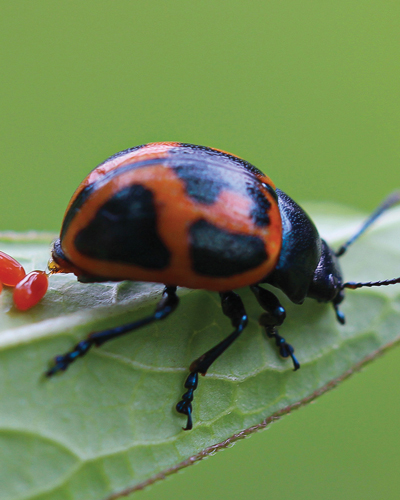 The milkweed leaf beetle (Labidomera clivicollis) is another milkweed specialist. In addition to monarch butterflies, there is a whole community of insects that are milkweed specialists including red milkweed beetles, milkweed tiger months, and large milkweed bugs. |
|
Is the insect apocalypse upon us? I don't know about that, but I do know that research shows that some insect populations are fluctuating in alarming ways. That should make us sit up and take notice. The time to take action is not after critical insect populations have disappeared. |
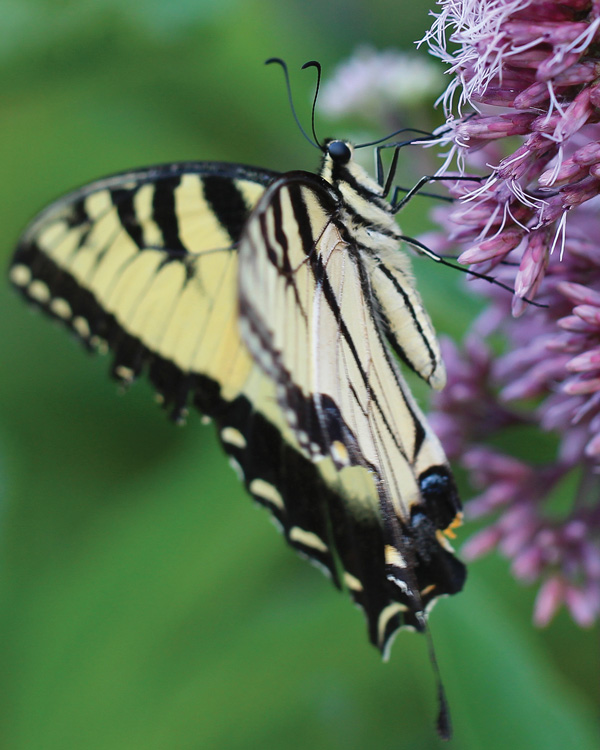 Tiger swallowtail (Papilio glaucus) nectaring on hollow Joe Pye weed (Eutrochium fistulosum). Joe Pye weeds are great plants for attracting butterflies to your garden. |
|
What can we do in our own corner of the world, in our own gardens, fields and forests? We can indeed be, as Mahatma Gandhi expressed, "the change we want to see in the world." First, because we are all afraid of what we do not know, learn the insects that live around you. How many beneficial or benign insects are killed for simply 'being'. If you have spiders in your house, congratulations! They are there eating other insects in your home. Even the scary-looking insects may, in fact, be beneficial. |
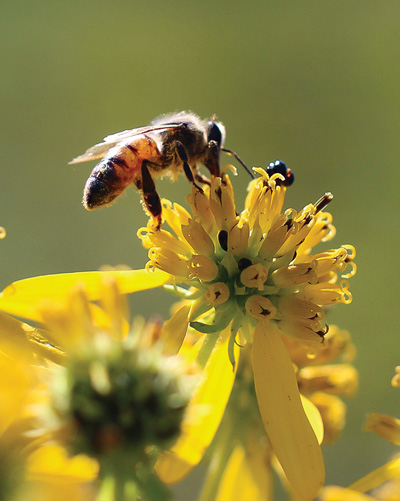 A honey bee (Apis mellifera) visits wingstem (Verbesina alternifolia) aka golden honey plant. These flowers are an important source of late summer nectar and pollen for honey bees, native bees, beetles, butterflies and many other insects. |
|
New Jersey has about four hundred species of native bee, many of which are ground nesting (such as plasterer and digger bees), or cavity nesting (such as bumble bees, leaf-cutter bees, and mason bees). These are all creatures that need to be embraced and encouraged to thrive all around us. |
|
Why are native plants in the landscape important? The fact of the matter is, most plant-eating insects can survive only on the plants that they have co-evolved to feed upon-not plants that have been introduced from hundreds of miles away, or from other continents. |
|
Monarch butterflies (Danaus plexippus), with their well-documented annual migration, have long been the darlings of the native plant movement. There has been a great deal of education about the importance of milkweed to monarchs, as well as the need to create suitable habitat. It is not enough to simply put out pretty flowers for the adults to feed on, although season-long nectar availability for adults is certainly a critical part of the equation. Monarchs, like many butterflies, will feed on a wide range of nectar-bearing flowers. It is their young, their caterpillars, that MUST have milkweeds to feed upon. |
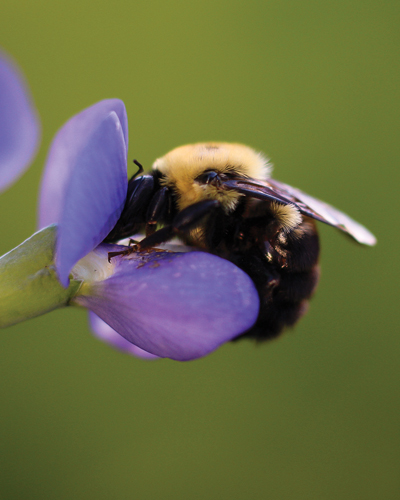 A queen bumble bee (Bombus sp.) visits blue false indigo (Baptisia australis) for nectar and pollen. |
|
But monarchs are only one of the many species that rely upon a particular host plant. What about all of the others? The folks at the North American Butterfly Association tell us there are about 725 species, and literally thousands of species of moths, as many as twelve thousand! Many of these insects require specific host plants for their survival. |
|
The white-M hairstreak (Parrhasius m-album) is one of many butterflies and moths that require oaks for their caterpillars. Red-banded hairstreak caterpillars prefer winged sumac (aka shining sumac) or staghorn sumac. Hackberry and tawny emperor butterflies rely on the majestic and under-appreciated hackberry tree, which hosts more than forty species of caterpillar. Other than the emperors, hackberries also host mourning cloaks (Nymphalis antiopa), ruddy dagger moths (Acronticta rubricoma), and question mark butterflies (Polygonia interrogationis). |
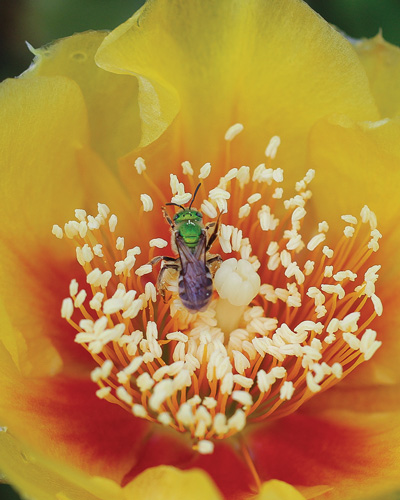 A bicolored striped sweat bee (Agapostemon virescens) visiting our native eastern prickly pear cactus (Opuntia humifusa) to collect pollen. |
|
The ranges of some wildlife are expected to shift as the effects of global warming become more pronounced. More southern species, like the zebra swallowtail (Eurytides marcellus), or the sleepy orange (Abaeis nicippe) butterflies, may shift northward. These two species, for example, are typically found as summer strays in New Jersey. In both cases, these insects need very particular host plants. Zebra swallowtail caterpillars feed on pawpaw trees, a small understory species on the northern end of the our region's range. Sleepy orange butterflies, on the other hand, rely on wild senna (Senna sp.). These insects cannot reproduce in an area without their host plants. If you plant these plants, will the butterflies show up? Maybe. But if those plants are not in the landscape, those butterflies will never reproduce there. |
|
As we talk about insects and host plants, we must remember that we cannot support insects by only supporting and admiring the adults, or just butterflies. As noted above, vast quantities of caterpillars become bird food. Without caterpillars, we will see no butterflies, no moths, and very few birds! Because most insects are host specific, we must allow them to create a few holes in our leaves. Since birds prey on insects of all kinds, most of our native insects actually camouflage themselves very well and their damage is usually minor or hard to detect. Most of the serious insect damage that we find is due to introduced pests like Japanese Beetles, Emerald Ash Borers, or Gypsy Moth, all of which were all introduced from parts of Asia. |
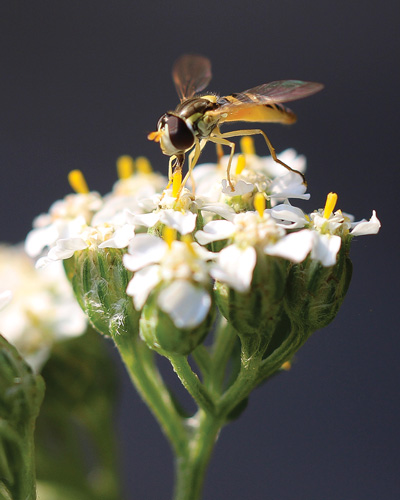 Flower flies (aka hover or Syrphid flies) are beneficial insects whose larvae feed on aphids and other soft-bodied insects. The adults are important pollinators of many plants. |
|
To encourage a diversity of insects in our gardens, we must also think about where those insects spend the winter. Unlike the monarch butterfly (that flies to Mexico), most of our native insects overwinter right in our gardens. Some native bees overwinter in the hollow stems of plants like Joe Pye weed. Most butterflies and moths overwinter as eggs attached to host plants or as pupae (chrysalises) either attached to stems or structures, or tucked away in the leaf duff. bumble bee queens overwinter in leafy nests on the ground. When we rake away all of the leaves and stems from our gardens each fall, we actually remove the vast majority of our overwintering butterflies, beetles, moths, native bees, and other insects and discard them. If you must clean up your gardens, leave the leaves and place the stems gently in a brush pile on the edge of your property so that wildlife that you tried so hard to attract to your garden (butterfly gardens, anyone?) are not thrown away with the trash. |
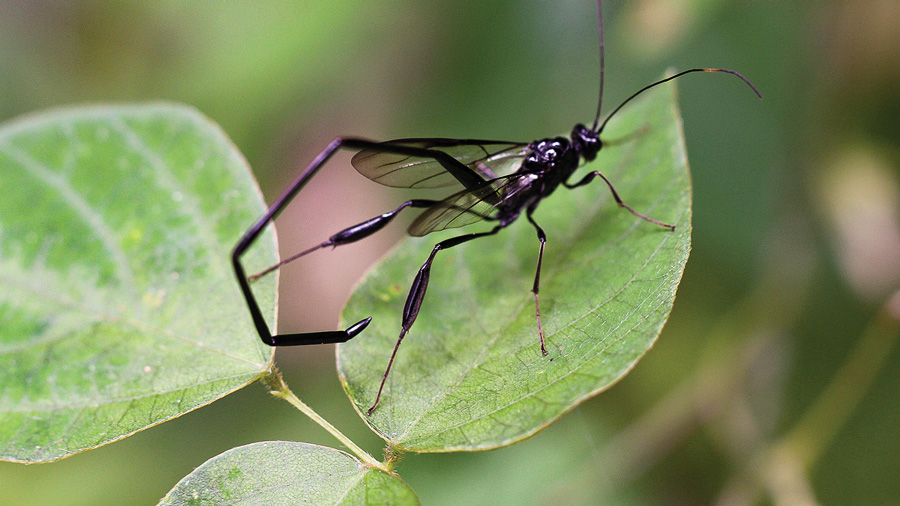 This pelecinid wasp (Pelecinus polyturator) resting on ticktrefoil (Desmodium sp.) is about 2.5" long. But she parasitizes white grubs in the soil (June beetle grubs). She is a beneficial insect who is entirely unaggressive and ignores humans completely. |
|
On beyond monarchs and bumble bees, we must learn to embrace and encourage other insects as well - even the scary looking ones. Assassin bugs are wonderful predators, and most wasps are actually parasites of other insects. Even lady beetles have a reputation problem. Much like butterflies, beetles have holometabolous or complete development meaning, basically, that the young do not look like the adults. People who would never hurt a lady beetle (because they know they are beneficial insects) will still quail in terror when they see a ladybeetle larvae or pupae. Dragonflies and damselflies are widely admired, but their predaceous aquatic young are intimidating to look at and are unidentifiable to most people. |
|
So, remember, the insects in your gardens not only belong there, but they need our help. They need lots of native plants to provide food and refuge for predators, parasites and yes - the birds that eat many of our insects. Diverse gardens, fields, hedgerows, and forests can support a lot of creatures and make your garden more alive with all sorts of wildlife including birds, butterflies, beetles, moths, and all manner of interesting creatures. Get to know these animals, and your life will be richer. |
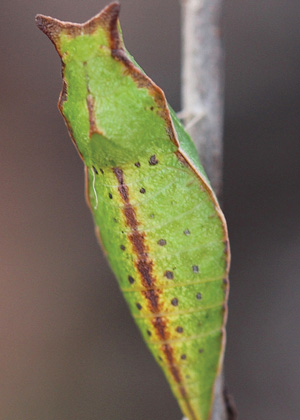 A spicebush swallowtail butterfly chrysalis (Papilio troilus) patiently awaits spring. |
|
There are a lot of great web sites and resources out there to help you learn, such as
|
|
Great web resources include Inaturalist.org, Bugguide.net, Nabanj.org, and Butterfliesandmoths.org |
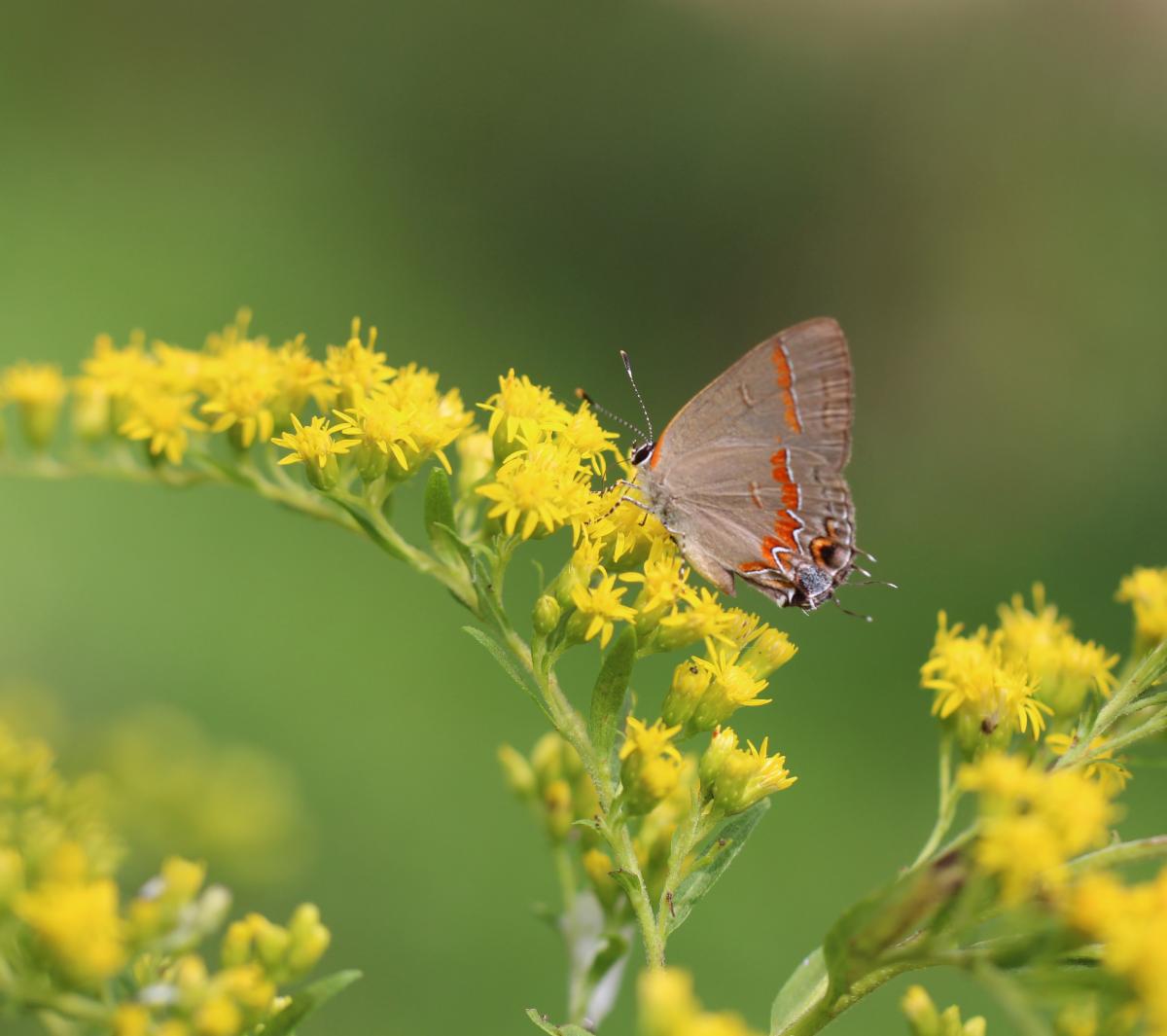 A red-banded hairstreak (Calycopus cecrops) nectaring on a giant goldenrod (Solidago gigantea). This photo by Randi was used as the cover of the Spring 2020 issue of Skyland Visitor magazine. |

Randi V.W. Eckel, PhD
